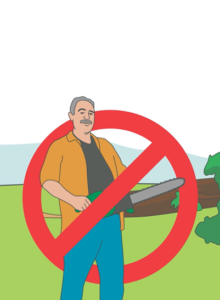Tree safety and responsibilities
Trees near power lines are dangerous. Touching fallen lines or while climbing or pruning trees can mean serious injury or death.

Trees near power lines are dangerous. Touching fallen lines or while climbing or pruning trees can mean serious injury or death.
Trees and branches too close to power lines are dangerous to people and livestock. They also cause interruptions to our power supply, especially during high winds and storms.
Plant trees well away from power lines. Try to keep branches trimmed before they grow too close to power lines.
If you have a tree-related enquiry please complete the form below and we will be in touch.
To report a tree hazard near lines, give our vegetation team a call on 0800 367 546

Bad weather can cause trees to topple onto power lines.
Stay clear of downed or low-hanging lines, keeping yourself and children at least 10 metres away.
Coming close or into contact with lines can result in severe injury and even death.
You don’t have to touch power lines to suffer electrocution; electricity can jump out from lines and even travel through equipment. Keep well away and refrain from touching, retrieving, or trying to move anything entangled with lines.
If you see a low-hanging or downed power line, stay away, and call us immediately on 0800 367 546.

Do not chop or cut trees touching or within 4 metres of power lines.
Working with trees which are contacting or near power lines is extremely dangerous. Touching or coming close to lines can result in severe or fatal injury.
If a tree is on or near lines, stay away and call our team.
To report a tree hazard near lines, give our vegetation team a call on 0800 367 546

If you own the land the tree is growing on, then generally you’re responsible for keeping trees trimmed and away from the lines. In some cases, it may be too dangerous for you to do the work yourself and you’ll need to arrange for us or an approved contractor to do it.
In certain situations, for example, a self-sown tree, you can declare ‘no interest’ in the tree and we’ll take responsibility for keeping it clear of the lines. Usually, we’ll fell the tree to save further maintenance costs.
We do regular tree surveys and line inspections and do our best to let you know if your tree is getting too close to the lines. However, we also need you to keep an eye out.
Download our brochure on Trees and Safety for more information:
The Electricity (Hazards from Trees) Regulations 2003 outline legal minimum distances trees should be kept from power lines. Tree owners can be fined up to $10,000 for not complying with these regulations.
The right tree in the right place goes a long way to avoiding problems with power lines and cables. Here’s a handy species selection and planting guide to help:

| Line Voltage |
Limit Zone |
Zone |
Only Zone |
| 33kV | 2.5m | 3.5m | 4.0m |
| 11kV | 1.6m | 2.6m | 4.0m |
| 230-400V | 0.5m | 1.5m | 4.0m |
This extends 2.5 metres out from power lines and conductors. This is the legal minimum space that must be kept clear of trees, and may vary depending on the voltage of the power lines.
This extends 3.5 metres out from power lines and conductors.
If your tree is growing in the Notice Zone, we may send you a Hazard Warning Notice advising that the tree needs trimming.
This extends 4.0 metres out from the power lines and conductors.
No person or piece of equipment is permitted within 4 metres of our lines.
For safety reasons, trees and vegetation in the Professional Only Zone can only be trimmed by us or one of our approved contractors. We’ll provide the first tree trimming free of charge but after that there’s a charge.
It’s important you don’t trim the trees in the Professional Only Zone yourself due to the risk of electrocution.